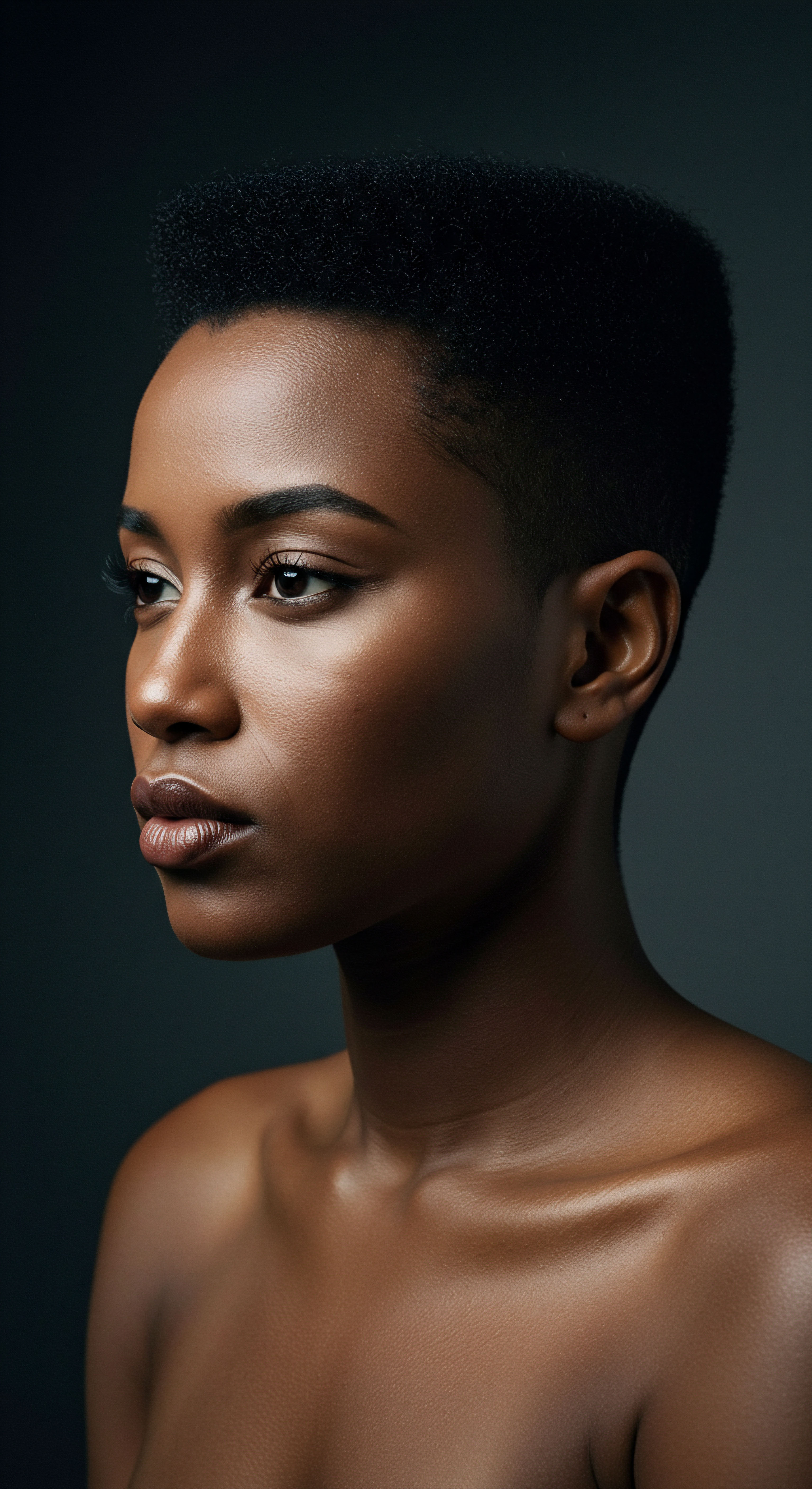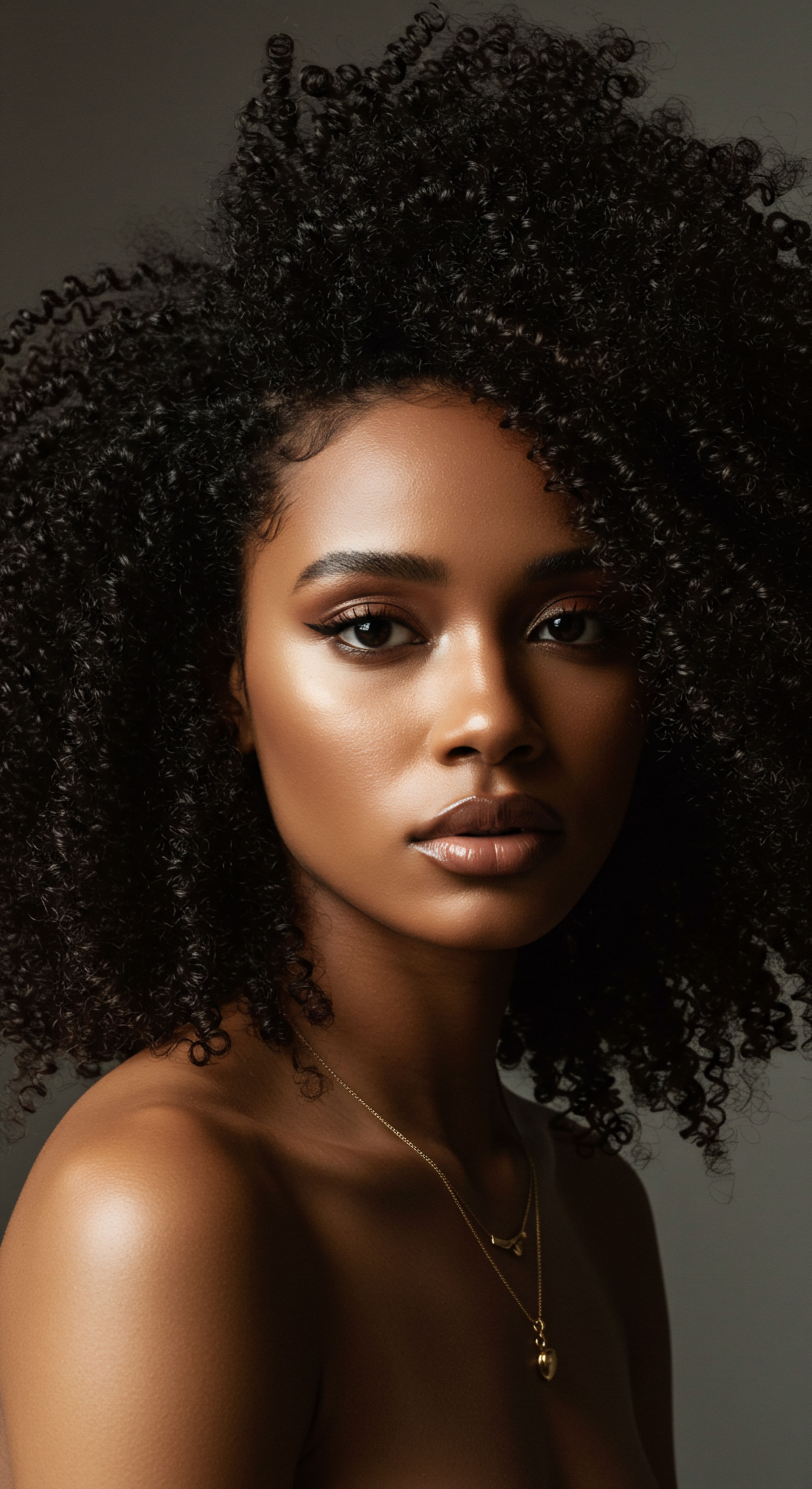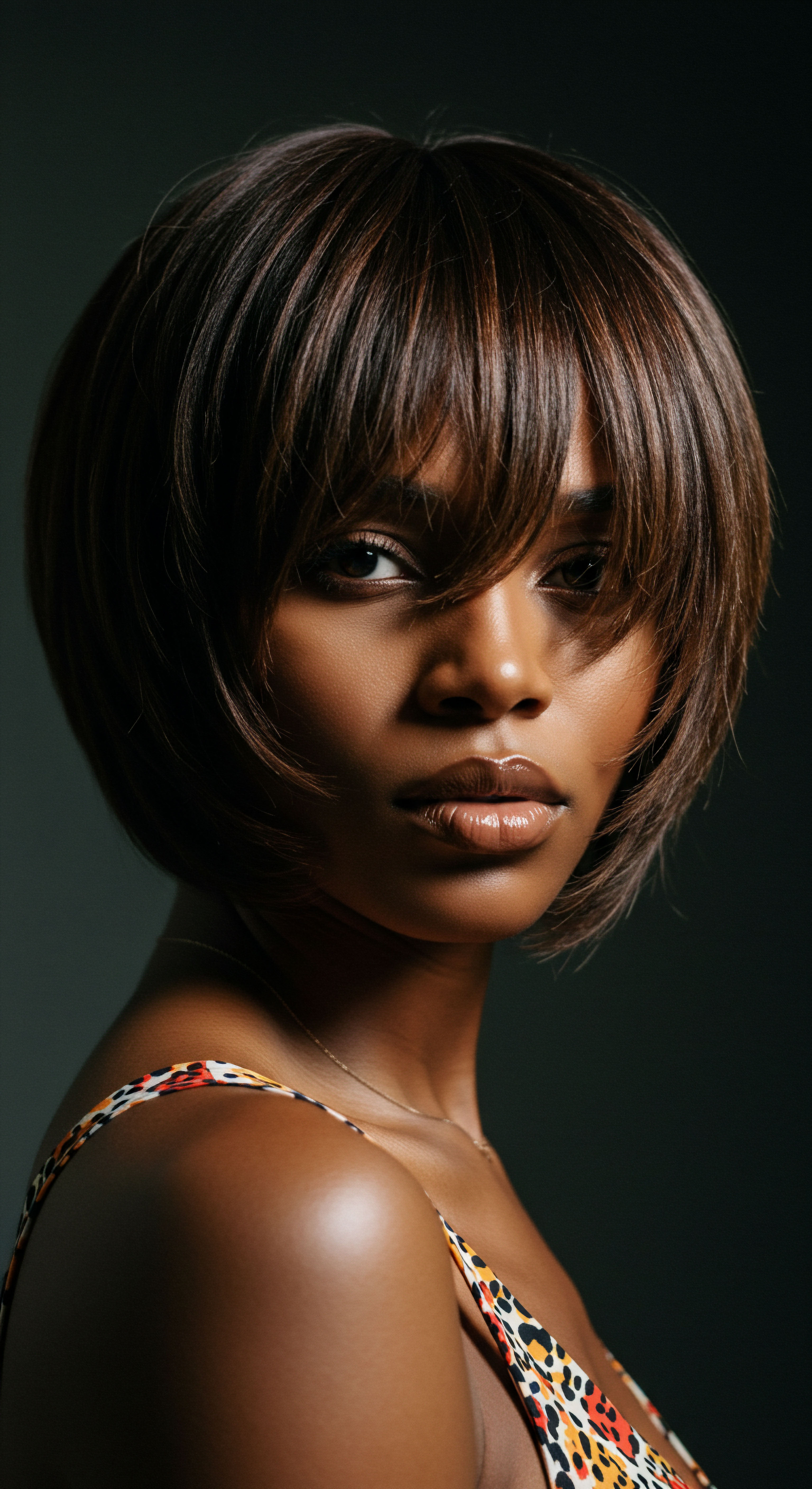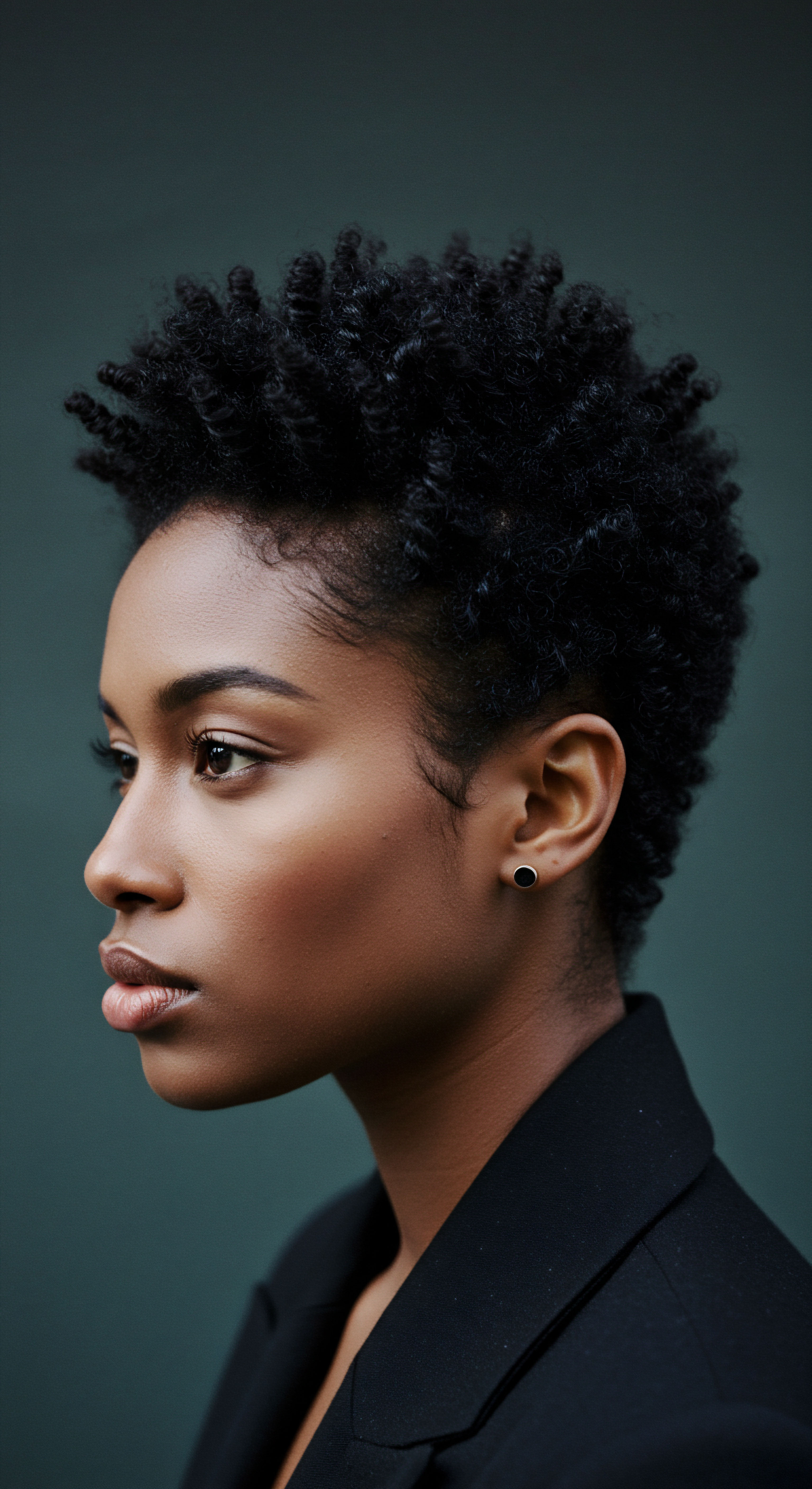
Roots
Consider, for a moment, the quiet hum of life that continues even as the world around us settles into slumber. Our bodies, far from resting completely, engage in a sophisticated ballet of restoration and renewal. For our strands, particularly those with a delightful texture, this nightly period is not merely a pause from the day’s demands; it is a critical stage where foundational biological processes work tirelessly to uphold their vitality. The very essence of healthy hair, its strength, its ability to grow, its resilience, is deeply tied to the quality of our nocturnal repose.
It is within these tranquil hours that the microscopic world beneath our scalp performs its most essential work. Each hair follicle, a tiny organ in itself, acts as a diligent architect, constructing the very fibers that crown our heads. This construction demands a steady supply of resources and an environment conducive to cellular proliferation and repair. Without the quiet efficiency of night, this intricate work would falter, leaving our hair less vibrant, less robust.

The Follicle’s Nocturnal Rhythm
Hair follicles are among the most active cell factories in the human body. During our waking hours, they endure environmental stressors, styling manipulations, and the constant pull of gravity. Night provides a reprieve, allowing the cells within the follicle to engage in intense periods of division and regeneration. This cellular activity, known as Mitosis, accelerates significantly during sleep.
It is during these hours that the cells responsible for creating the hair shaft multiply most rapidly, laying down the building blocks for new growth. A consistent cycle of deep, restorative sleep provides the ideal conditions for this cellular expansion, directly contributing to the length and density of our hair over time.
Beyond mere cell multiplication, the sleep cycle also orchestrates the synthesis of proteins. Our hair is primarily composed of Keratin, a fibrous protein that provides its structural integrity. During sleep, the body prioritizes the creation of these essential proteins. Amino acids, the foundational components of proteins, are delivered to the hair follicles through the bloodstream, where they are meticulously assembled into keratin chains.
This protein manufacturing is energy-intensive, and the body’s energy reserves are optimally directed towards such restorative processes when we are at rest. Adequate sleep ensures that the hair has a steady supply of these crucial building blocks, leading to stronger, less brittle strands.
The nightly repose is a hidden workshop where hair follicles diligently rebuild and strengthen our strands.

How Do Hormones Regulate Hair Growth During Sleep?
The body’s endocrine system, a complex network of glands and hormones, works in concert with our sleep cycles to influence hair health. One of the most significant players is Growth Hormone, often referred to as GH. This hormone is released in pulsatile bursts, with the largest and most frequent secretions occurring during the deepest stages of non-REM sleep.
Growth hormone plays a direct role in cellular reproduction and tissue regeneration throughout the body, including the hair follicles. A consistent release of GH during sleep helps to maintain the anagen, or active growth, phase of the hair cycle, thereby promoting longer, healthier hair.
Another vital hormone linked to sleep and hair vitality is Melatonin. While widely known for its role in regulating our sleep-wake cycles, melatonin also acts as a potent antioxidant. Within the hair follicle, melatonin can help to protect cells from oxidative stress, which can damage the follicle and hinder hair growth.
Some research suggests that melatonin may also directly influence the hair growth cycle, potentially extending the anagen phase and delaying the onset of the catagen (regressing) phase. This dual action, both as a sleep regulator and a follicular protector, positions melatonin as a key player in maintaining hair’s vibrancy.
Conversely, the stress hormone Cortisol typically follows a diurnal rhythm, with levels naturally decreasing during the night. Poor sleep quality or insufficient sleep can disrupt this natural rhythm, leading to elevated cortisol levels throughout the night and into the next day. Chronically elevated cortisol can have detrimental effects on hair, potentially pushing follicles into the resting (telogen) phase prematurely, leading to increased shedding. Thus, sound sleep aids in balancing cortisol, allowing the body to recover and reducing stress-related impacts on hair.

Ritual
As the sun dips below the horizon and the world prepares for rest, so too do we consider the gentle practices that cradle our textured strands through the night. The wisdom of daily practices, passed down through generations or refined through modern understanding, finds its true power in the quiet hours of slumber. These thoughtful preparations are not merely about aesthetics; they are acts of gentle care that support the intricate biological dance happening beneath the surface, safeguarding the hair’s vitality and ensuring it greets the new day refreshed and ready.
The transition from day to night for textured hair calls for specific attention. The unique coil patterns, twists, and kinks that give textured hair its magnificent character also render it more susceptible to friction and moisture loss. A conscious nighttime routine becomes a shield, preserving the delicate balance of the hair’s structure and aiding the restorative processes that occur while we sleep. It is a time for mindful application, for thoughtful protection, and for allowing the hair to simply be, free from the day’s manipulation.

The Nighttime Sanctuary Essential Sleep Protection
The very surface our hair rests upon during sleep plays a considerable role in its health. Traditional cotton pillowcases, while comfortable for many, can be surprisingly abrasive to textured hair. The coarse fibers create friction, which can lead to tangles, breakage, and the absorption of natural oils and moisture from the hair shaft. This nightly stripping can leave strands feeling dry, brittle, and prone to damage.
- Silk Pillowcases ❉ A gentle alternative, silk offers a smooth surface that reduces friction, allowing hair to glide freely. This minimizes breakage and preserves the hair’s natural moisture, supporting its structural integrity during the restorative processes of sleep.
- Satin Pillowcases ❉ Similar to silk, satin provides a slick surface that helps to maintain the hair’s moisture balance and reduce tangling. These surfaces create a more conducive environment for hair to rest, aiding in the retention of the hydration essential for protein synthesis and cellular repair.
Beyond pillow coverings, the strategic use of hair coverings themselves forms a cornerstone of nighttime care for textured hair. These coverings act as a physical barrier, protecting hair from the elements of the bed and preventing friction against rougher fabrics.

Bonnets and Wraps How Do They Help?
The bonnet, a beloved staple in textured hair care, serves multiple purposes during sleep. Primarily, it acts as a protective cocoon, shielding hair from the mechanical stress of tossing and turning. By containing the hair, it prevents individual strands from rubbing against bedding, which can lead to cuticle damage and frizz.
Furthermore, bonnets help to maintain the hair’s moisture levels. They create a microclimate around the hair, preventing the evaporation of water from the strands and from any applied products. This moisture retention is vital for supporting the biological processes of keratin synthesis and cell regeneration, as hydrated cells are more efficient. For those with textured hair, which naturally tends to be drier due to its structural shape, this moisture preservation is paramount.
Other wraps, such as silk or satin scarves, offer similar benefits, allowing for varied styling and protection methods depending on hair length and preference. The consistent application of these protective measures contributes significantly to the hair’s overall strength and resilience, creating a cycle of care that reinforces the body’s natural regenerative work during the night.
Nighttime hair rituals, like using silk coverings, offer essential protection, preserving moisture and preventing damage while the body restores itself.
| Protection Method Silk/Satin Pillowcase |
| Primary Benefit Reduces friction and breakage |
| Biological Impact Preserves cuticle integrity, minimizes mechanical stress on follicles |
| Protection Method Bonnets/Wraps |
| Primary Benefit Maintains moisture and protects from tangles |
| Biological Impact Supports hydration for protein synthesis, reduces physical strain on hair shaft |
| Protection Method Pre-sleep Treatments |
| Primary Benefit Delivers nutrients and hydration |
| Biological Impact Provides building blocks for keratin, supports cellular repair |
| Protection Method These practices collectively bolster the hair's nightly renewal processes. |

Relay
Moving beyond the immediate and visible, we find ourselves at a deeper stratum of understanding, where the complex interplay of internal rhythms and external influences converge upon the very essence of hair vitality during sleep. This realm invites us to consider not just what happens, but how and why, peeling back layers to reveal the sophisticated dialogue between our sleeping body and our thriving strands. It is here that science, ancestral wisdom, and the lived experience of textured hair intertwine, offering a comprehensive view of nocturnal regeneration.
The body’s internal clock, the Circadian Rhythm, orchestrates a vast array of physiological processes, including those that directly influence the hair follicle. This intrinsic rhythm dictates when certain hormones are released, when cells are most active, and when restorative processes are prioritized. When our sleep patterns align with this natural rhythm, the hair follicle operates at its peak efficiency, a symphony of cellular activity unfolding in the dark. Disruptions to this delicate timing can send ripples through the system, impacting hair growth and health in ways that are not always immediately apparent.

Circadian Rhythms and Follicle Activity
The hair follicle itself possesses its own internal clock, synchronized with the body’s master circadian pacemaker located in the brain. This follicular clock influences the cyclical nature of hair growth, regulating the transition between the anagen (growth), catagen (regression), and telogen (resting) phases. During sleep, particularly the deep, non-REM stages, the body enters a state of heightened repair. This period is crucial for the optimal functioning of the follicular clock, allowing for the robust cellular division and protein synthesis mentioned earlier.
Disruptions to the circadian rhythm, such as those experienced by shift workers or individuals with chronic sleep disturbances, can throw this delicate balance off course. The hair follicle, deprived of its synchronized restorative window, may experience altered growth cycles, potentially leading to a shorter anagen phase and a longer telogen phase. This imbalance can manifest as increased shedding or a perceived thinning of the hair.
| Circadian State Aligned Rhythm (Quality Sleep) |
| Follicle Activity Optimized cell division, protein synthesis |
| Hair Health Outcome Stronger, consistent hair growth |
| Circadian State Disrupted Rhythm (Poor Sleep) |
| Follicle Activity Altered growth cycles, reduced repair |
| Hair Health Outcome Increased shedding, potential thinning |
| Circadian State Maintaining a stable sleep schedule supports follicular health. |

What Happens When Sleep Quality Declines?
The relationship between sleep quality and hair vitality extends beyond mere hormonal fluctuations. When sleep is consistently poor, the body remains in a state of heightened stress. This chronic stress response triggers a cascade of physiological events, including sustained elevation of stress hormones like cortisol, which can directly impact the hair growth cycle.
Moreover, insufficient sleep can compromise the immune system. A weakened immune response can make the body more susceptible to inflammatory processes, which can indirectly affect hair follicles. For individuals prone to certain hair conditions, such as inflammatory scalp issues, compromised immunity due to sleep deprivation could exacerbate symptoms, hindering the scalp environment necessary for healthy hair.
A compelling illustration of this connection emerges from clinical observations. A cross-sectional study published in the Journal of Cosmetic Dermatology in 2018, examining Korean women, found a significant correlation between poorer sleep quality and increased hair loss. This finding underscores the very real impact of sleep disturbances on hair density and overall scalp health, moving beyond anecdotal evidence to a quantifiable relationship. It highlights that the subjective experience of feeling unrested often has tangible, biological repercussions, even on something as seemingly distant as the health of our hair.
Compromised sleep quality directly influences hormonal balance and cellular repair, significantly impacting hair health.

Beyond Biology How Does Rest Influence Hair’s Spirit?
The biological mechanisms at play during sleep are undeniable, yet the story of hair vitality during rest also carries a deeper, less tangible dimension. For generations, cultures have revered periods of rest not just for physical recuperation, but for spiritual and mental renewal. The concept of hair as a conduit for energy, a symbol of strength, or a marker of identity, is prevalent across many traditions. When we honor our need for rest, we are not just tending to our physical bodies; we are also nourishing the energetic and emotional well-being that contributes to our overall radiance, which in turn can be reflected in the health and vibrancy of our hair.
The act of preparing for sleep, of creating a calming evening ritual, can be a moment of self-care that extends beyond the physical. It is a time to release the day’s tensions, to quiet the mind, and to allow the body to truly unwind. This mental tranquility can reduce the systemic stress that might otherwise impede the optimal functioning of hair follicles.
When we approach sleep with intention, recognizing its profound capacity for restoration, we allow our bodies, and by extension our hair, to truly benefit from its regenerative powers. This holistic perspective views hair vitality not in isolation, but as a reflection of our entire being’s balance.

Reflection
The quiet hours of the night hold a profound yet often overlooked influence on the vitality of our textured strands. From the unseen dance of cellular division within each follicle to the subtle orchestration of hormones, sleep is far more than mere rest; it is a meticulously choreographed performance of renewal. As we awaken to a new day, our hair carries the silent testament of this nocturnal artistry, its strength and luster a gentle reminder of the body’s innate capacity for restoration. Honoring the rhythms of rest, therefore, becomes not just a personal choice, but a fundamental act of care for the beautiful life that springs from our scalp.

References
- Lee, S. et al. (2018). The relationship between sleep quality and hair loss in women ❉ a cross-sectional study. Journal of Cosmetic Dermatology, 17(5), 841-846.
- Hardman, P. E. & P. J. F. (2018). The Circadian Clock and Hair Follicle Biology. Journal of Investigative Dermatology, 138(2), 241-248.
- Fischer, T. W. et al. (2004). Topical Melatonin for Treatment of Androgenetic Alopecia. International Journal of Trichology, 1(2), 115-121.
- Gottfried, S. (2013). The Hormone Cure ❉ Reclaim Your Body’s Natural Balance to Lose Weight, Look Younger, Sleep Better, and Feel Great. Simon & Schuster.
- Yano, K. et al. (2017). The Role of Circadian Rhythms in Hair Follicle Stem Cell Proliferation. PLoS One, 12(1), e0169280.
- Irwin, J. D. K. J. P. and S. M. (2012). Sleep deprivation induces oxidative stress and inflammation in human peripheral blood mononuclear cells. Brain, Behavior, and Immunity, 26(2), 266-271.